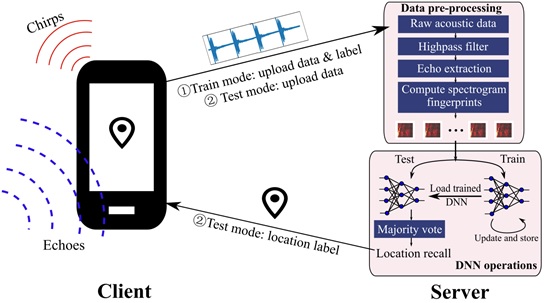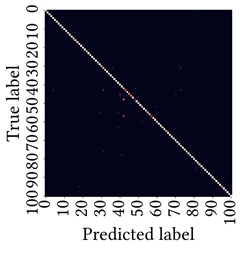EchoLoc
Video demo:
–
Smartphone-based localization has attracted wide research in recent years due to the proliferation of smartphones and the increasingly demanded location-aware services. In indoor environments, the global positioning system (GPS) are often unavailable due to the blockage of GPS signal and more stringent requirements of indoor positioning services. Therefore, a number of modalities such as Bluetooth and Wi-Fi are exploited to build smartphone-based indoor localization systems. These solutions are usually infrastructure-based, which require the installation of extra anchor points for localizing the smartphones. Excessive effort for infrastructure installation often stems the applicability of infrastructure-based indoor localization systems. Therefore, an accurate, reliable infrastructure-free indoor localization system will be more favorable compared with infrastructure-based systems.
EchoLoc is a deep neural network (DNN) based system for accurate and large-scale smartphone indoor localization using room acoustic responses. It has four salient advantages.
- EchoLoc is infrastructure free and only requires the access to the smartphone audio system. We show that the potential applications of EchoLoc span from small meeting rooms to large semi-open concert halls.
- EchoLoc achieves 95% location recall accuracy in a large public indoor space and sub-meter mean localization error in the tested lab office. This localization accuracy can support a range of location-based mobile services such as navigation, way finding, workspace clock-in, artwork interaction, emergency response, etc.
- EchoLoc works with normal hand grasping of the smartphone and require no special holdings of the phone.
- EchoLoc emits chirps in a frequency range from 15 kHz to 20 kHz, which lies in the nearly inaudible range of human ears. Therefore, EchoLoc is robust to ambient noise and causes little/no annoyance to users.

There are a few recent works exploiting smartphone acoustic system for indoor localization. However, they only achieve room-level localization or only evaluate the localization performance at a few locations per room.
EchoLoc performance is evaluated in a public indoor space and a lab area. Among the 101 fingerprinted locations in a large scale public indoor space, EchoLoc achieves a 95% location recognition accuracy (left figure below). Among the 61 locations fingerprinted in our lab area, EchoLoc achieves an 81% location recognition accuracy and sub-meter mean localization error (right figure below).


EchoLoc can support a range of location-based mobile services such as navigation, way finding, workspace clock-in, artwork interaction, emergency response, etc., in various indoor environments.
To give some example, in an office building, EchoLoc can be used for employee clock-in or phone-nearby required device unlock. In a large shopping mall, EchoLoc can help customers to locate their positions and provide guidance toward a specific shop. In a hospital, EchoLoc can be used for patients’ location monitoring and emergency response. In a gallery or museum, visitors can trigger the narration of an artwork using EchoLoc just in front of it.
The demo abstract was published on SenSys'21 Demo (PDF).
